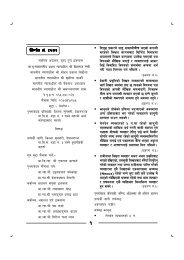The Nepali Judiciary - Supreme Court Of Nepal
The Nepali Judiciary - Supreme Court Of Nepal
The Nepali Judiciary - Supreme Court Of Nepal
Create successful ePaper yourself
Turn your PDF publications into a flip-book with our unique Google optimized e-Paper software.
Chapter Five<br />
Core Functions<br />
Pursuant to the responsibility vested by the Constitution and law and from the past experience of<br />
the previous Plan, the core functions of the court are as follows: adjudication, execution of<br />
judgment and inspection and supervision. <strong>Court</strong> management which was defined as one of the<br />
core functions in the first Plan has been included as one of the strategic intervention designed to<br />
assist decision making and execution of judgment. Since, strategic interventions assist in the<br />
effective implementation of the core functions, coordination between strategies and strategic<br />
interventions have been made.<br />
5.1 Adjudication<br />
Under this, adjudication of cases has been included under this function, which includes<br />
adjudication function from the <strong>Supreme</strong> <strong>Court</strong> to the District <strong>Court</strong> and other courts and tribunals.<br />
Core Function<br />
1. Adjudication Function<br />
Result Indicators Strategies<br />
1.1 Examine the constitutionality<br />
of law<br />
1.2 Issue orders under writ<br />
jurisdiction for protection of<br />
fundamental and legal rights and<br />
public interest<br />
1.3 Dispose cases through the<br />
application of original and<br />
appellate jurisdiction (including<br />
courts, Special <strong>Court</strong>s and<br />
tribunals)<br />
• Dispose all disputes related to<br />
constitutionality of law within<br />
one year<br />
• Dispose all writ petitions within<br />
one year from the date of<br />
registration<br />
• Reduce pending 113 writ petition<br />
by 75% (15% each year) during<br />
the Plan period<br />
• Dispose all disputes related to<br />
constitutionality law within one<br />
year<br />
• Dispose all cases within the<br />
limitation prescribed by law, not<br />
to exceed two years. 114<br />
• Reduce pending cases by 50%<br />
(10% each year) during the Plan<br />
period<br />
• Reform in case management<br />
system<br />
• Develop capacity of human<br />
resource<br />
• Management of logistic<br />
deemed necessary<br />
• Increase application of<br />
information technology<br />
• Bring effectiveness in<br />
inspection and supervision<br />
• Reform in security<br />
•<br />
management<br />
Promote judicial<br />
•<br />
independence and autonomy<br />
Effort to reform laws for<br />
enhancing judicial service<br />
• Strengthen<br />
stakeholders<br />
relation with<br />
• Increase access to justice<br />
• Institutional strengthening of<br />
court<br />
bodies<br />
and other judicial<br />
5.2 Execution of Judgment<br />
Under this function falls execution of judgments made by the <strong>Supreme</strong> <strong>Court</strong> to the District <strong>Court</strong>s<br />
and this also includes any orders, decisions made by other courts, tribunals and mediation.<br />
113<br />
Pending cases denotes writ petitions not disposed within the period prescribed by the Plan from the date of<br />
registration<br />
114<br />
Cases shall be disposed within the first year for those cases that prescribed limitation and for those that have no<br />
limitation, cases shall be decided within a period two years.<br />
71




![lg0f{o g+=&(&# g]=sf=k= @)^% ;af]{Rr cbfnt ljz]if Ohnf; ;DdfggLo k ...](https://img.yumpu.com/10045627/1/190x245/lg0fo-g-gsfk-afrr-cbfnt-ljzif-ohnf-ddfgglo-k-.jpg?quality=85)
![lg0f{o g+=&(@% g]=sf=k= @)^% ;jf]{Rr cbfnt, ljz]if Ohnf; dfggLo ...](https://img.yumpu.com/6479513/1/190x245/lg0fo-g-gsfk-jfrr-cbfnt-ljzif-ohnf-dfgglo-.jpg?quality=85)

![lgj]b s ljkIfL - Supreme Court Of Nepal](https://img.yumpu.com/5482729/1/190x245/lgjb-s-ljkifl-supreme-court-of-nepal.jpg?quality=85)